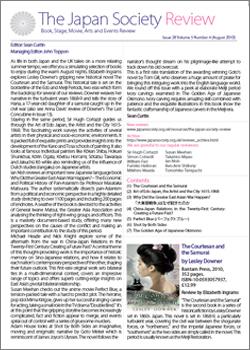Issue 28 (August 2010, Volume 5, Number 4)

As life in both Japan and the UK takes on a more relaxing summer tempo, we offer you a simulating selection of books to enjoy during the warm August nights.
Elizabeth Ingrams explores Lesley Downer’s gripping new historical novel The Courtesan and the Samurai. This historical tale is set on the borderline of the Edo and Meiji Periods, two eras which form the backdrop for several of our reviews. Downer weaves her narrative in the turbulent years 1868-9 and tells the story of Hana, a 17-year-old daughter of a samurai caught up in the civil war (also see Anna Davis’ review of Downer’s The Last Concubine in Issue 13).
Staying in the same period, Sir Hugh Cortazzi guides us through the Art of Edo Japan, the Artist and the City 1615- 1868. This fascinating work surveys the activities of several artists in their physical and socio-economic environments. It is packed full of exquisite prints and provides insights into the development of the Kano and Tosa schools of painting. It also looks at famous individual painters like Kōkan Shiba, Hokuei Shunkōsai, Kōrin Ogata, Kōetsu Hon’ami, Sōtatsu Tawaraya and Jakuchū Itō while also reminding us of the influence of Dutch studies (rangaku) on Japanese artists.
Ian Nish reviews an important new Japanese language book WhyDidtheGreaterEastAsianWarHappen?–TheEconomic and Political History of Pan-Asianism by Professor Masataka Matsuura. The author systematically dissects pan-Asianism from a political and economic perspective in a highly detailed study stretching to over 1100 pages and including 200 pages of endnotes. A swathe of the book is devoted to the activities of General Iwane Matsui, the Greater Asia Association and analysing the thinking of right-wing groups and officers. This is a masterly document-based study, offering many new perspectives on the causes of the conflict and making an important contribution to the study of this period.
Michael Heazle and Nick Knight explore some of the aftermath from the war in China-Japan Relations in the Twenty-First Century: Creating a Future Past? A central theme of this thought-provoking work is the importance of historic memory on Sino-Japanese relations, and how it relates to each nation’s contemporary perspective of the other, shaping their future outlook. This first-rate original work sets bilateral ties in a multi-dimensional context, covers an impressive range of topics and offers superb cutting-edge insights on East Asia’s pivotal bilateral relationship.
Susan Meehan checks out the anime movie Perfect Blue, a tension-packed tale with a hard to predict plot. The heroine, pop idol Mima Kirigoe, gives up her successful singing career for acting, taking a small role in the TV drama “Double Bind.” It’s at this point that the gripping storyline becomes increasingly complicated, fact and fiction appear to merge, and events spiral out of control with a series of gruesome murders. Adam House looks at Shot by Both Sides an imaginative, moving and enigmatic narrative by Goto Meisei which is reminiscent of James Joyce’s Ulysses. The novel follows the narrator’s thought stream on his pilgrimage-like attempt to track down his old overcoat.
This is a first rate translation of the awarding winning Goto’s novel by Tom Gill, who deserves a huge amount of praise for bringing this intriguing work into the English language world. We round off this issue with a peek at elaborate Meiji period ivory carvings examined in The Golden Age of Japanese Okimono. Ivory carving requires amazing skill combined with patience and the exquisite illustrations in this book show the fantastic craftsmanship of Japanese carvers in the Meiji era.
Contents
- The Courtesan and the Samurai
- Art of Edo Japan, the Artist and the City 1615-1868
- Why Did the Greater East Asian War Happen?「大東亜戦争」はなぜ起きたのか
- China-Japan Relations in the Twenty-First Century: Creating a Future Past?
- Perfect Blue (パーフェクトブルー)
- Shot by Both Sides
- The Golden Age of Japanese Okimono
Contributors
Editor
Sean Curtin
Managing Editor
John Toppon
Reviewers
Elizabeth Ingrams, Sir Hugh Cortazzi, Ian Nish, Sean Curtin, Susan Meehan and Adam House

